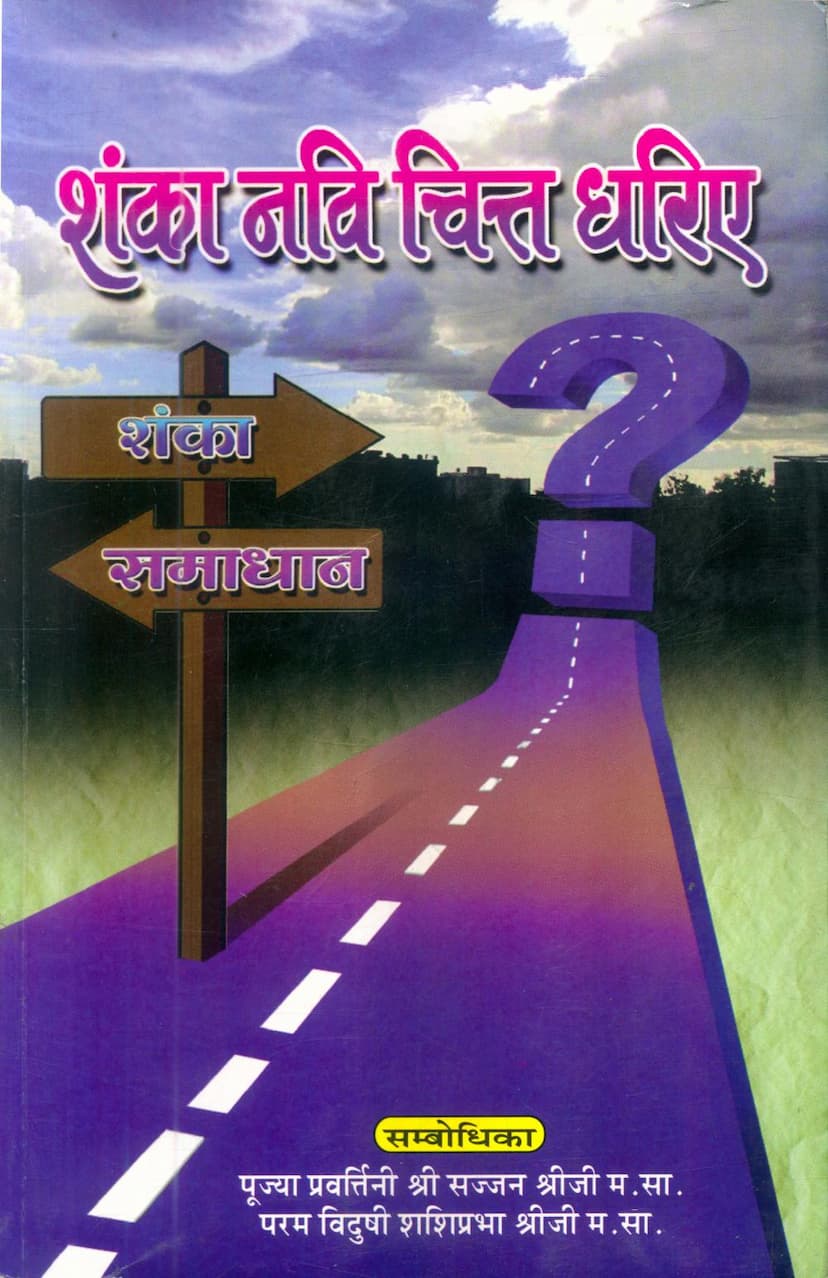Shanka Navi Chitta Dharie Shanka, Samadhan
Added to library: September 2, 2025

Summary
This document is the 23rd volume in the "Sajjan Mani Granthamala" publication series, titled "Shanka Navi Chitta Dharie-Shanka, Samadhan" (Don't hold doubts in your mind - Doubt, Solution). It is authored by Saumyagunashreeji and published by Prachya Vidyapith.
The book is essentially a comprehensive exploration and critical study of Jain rituals, customs, and principles, presented in a question-and-answer format. It aims to clarify common doubts and provide solutions based on Jain scriptures and traditions.
Here's a breakdown of the key aspects and themes covered in the provided pages:
Core Purpose: The book's primary goal is to address and resolve the doubts and questions that arise in the minds of Jain followers, particularly concerning the practical application and understanding of Jain rituals and beliefs in the modern era. It seeks to provide clarity and guidance, especially to the younger generation, who may be drifting away from traditional practices due to perceived complexities or the influence of Western culture.
Key Themes and Content Areas:
- Jain Rituals and Practices (Vidhi-Vidhan): The bulk of the content revolves around explaining and justifying various Jain rituals. This includes:
- Temple Worship: Questions about why temples are built, the significance of idols, the proper way to worship, the use of materials like camphor, sandalwood, and flowers, the necessity of prostrations (namaskar), and the meaning behind different types of pujas (e.g., Panchopachari, Ashtopachari, Sarvopachari).
- Temple Management: Discussions on the proper maintenance of temples, the use of idols, the arrangement of idols, the significance of symbols like the Swastika (Sathiya), the use of lamps (Deepak), and the proper handling of temple offerings (nirman).
- Specific Rituals: Explanations of rituals like Pratikraman, Samayik, Chaitvavandan, and the rationale behind them.
- Temple Architecture and Design: Questions about the placement of idols, the significance of specific architectural elements, and the use of materials.
- Daily Practices: Guidance on daily observances, such as when to offer prayers, the significance of specific times for worship, and the use of sacred substances.
- Social and Community Practices: The importance of collective worship (Samuhik Aradhana) and its benefits.
- Idol Worship (Pratimapujan): A significant portion of the book is dedicated to defending and explaining the practice of idol worship in Jainism. It addresses questions like:
- Why are idols worshipped when Jainism emphasizes the formless nature of the soul?
- What is the benefit of making and worshipping idols?
- Can idols made of clay or other materials be worshipped?
- The significance of the divine iconography, such as the specific features of Tirthankar idols.
- The practice of performing Abhishek (ritual bathing) and decorating the idols.
- Devotional Practices: The text delves into various forms of devotion, including prayer, chanting (Japa), and singing hymns (Bhajan).
- Ethical and Philosophical Underpinnings: The book seeks to connect rituals with their underlying philosophical principles, emphasizing concepts like:
- Ahimsa (Non-violence): How rituals are performed in a way that minimizes harm to living beings.
- Vairagya (Detachment): How rituals help cultivate detachment from worldly desires.
- Karma: The role of rituals in the process of karma mitigation and spiritual progress.
- Samayik: The importance of equanimity and contemplation.
- Addressing Doubts: The title itself, "Shanka Navi Chitta Dharie - Shanka, Samadhan," signifies the book's central theme of resolving doubts. It tackles questions raised by modern interpretations, skepticism, and the influence of other traditions.
- Role of Gurus and Authorities: The book frequently references the guidance and teachings of various Jain monks and scholars (Acharyas, Upadhyayas, Munis, Sadhvis), highlighting the importance of lineage and traditional authority in interpreting and practicing Jainism.
- Historical Context of Rituals: The text often discusses the evolution of certain practices, explaining how they might have originated or changed over time, distinguishing between ancient and later scriptural interpretations.
- Practical Guidance: It offers practical advice on how to perform rituals correctly, the appropriate use of materials, and the correct etiquette within Jain temples.
- Support and Contributions: The book acknowledges the contributions of various individuals and organizations that supported its publication, including the Sajjanmani Granthamala, the publisher Prachya Vidyapith, and specific patrons like Shri Kantilalji Mukim. It also features dedications and blessings from prominent Jain spiritual leaders.
Structure and Tone: The book is structured around questions and answers, making it accessible for readers seeking clarification on specific points. The tone is informative, persuasive, and reverent, aiming to educate and inspire confidence in Jain practices. The extensive citations of scriptures and authorities lend credibility to the explanations provided.
Key Figures: The book is a result of extensive research by Dr. Sadhvi Saumyaguna Shri, under the guidance of Dr. Sagarmal Jain. It is also dedicated to and influenced by prominent Sadhvis like Pujya Pravartini Shri Sajjan Shri ji M.Sa. and Param Vidushi Shashi Prabha Shri ji M.Sa.
Overall Significance: "Shanka Navi Chitta Dharie-Shanka, Samadhan" appears to be a valuable resource for Jain followers looking to deepen their understanding of their faith's rituals and traditions. It aims to bridge the gap between ancient scriptural teachings and modern-day practice, ensuring the continuity and relevance of Jain practices for contemporary society. The sheer volume of the research (23 volumes mentioned for the D.Litt.) indicates a deep and thorough investigation into Jain ritualistic literature.